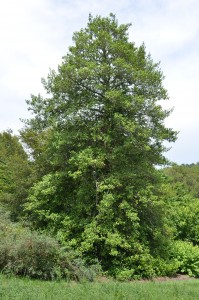American Holly (Ilex opaca) is a pyramidal evergreen tree that deserves to be planted more for multiple reasons. It is native to the eastern and central U. S. and is easily identified by its spiny green leaves (USDA hardiness zones 5 to 9).
It grows slowly to 15 to 35 feet, sometimes taller. The leathery, deep green leaves (2-4 inches long) are spiny-tipped along the leaf margins. Hollies are dioecious, e.g. individual plants are sexed either male or female.
Greenish-white flowers appear in May-June. Bright red or golden yellow ¼ – ½ inches diameter drupe fruits (“berries”) ripen on female trees in fall and persist on the tree through winter. For good fruit set male and female hollies needed to be planted within ½ mile apart.
American holly grows in any average soil, but fails in poorly drained or soils that periodically flood. In northern zone holly grows in full day sun and prefers partial afternoon shade in southern region (7b -9). In early spring feed a slow-release fertilizer specifically labelled for acidic loving plants.
Holly foliage and berries are used for winter holiday wreaths and other decorations. The tree provides shelter for birds from harsh weather and predators; holly berries are a steady food source all winter long. Spiny leaves contain toxic sap and are an adequate deterrent against deer.
American hollies are susceptible to leaf drop, leaf scorch and chlorosis (leaf yellowing in high pH soils). When properly sited, hollies have few disease and insect problems. Otherwise, the list of potential problems grows long.
Utilize as a single tree specimen or group several for foundation planting and for hedging. Foliage and fruits are superior winter features.
Over 100 cultivars of American hollies are identified and cataloged. Five exceptional cultivars are:
‘Dan Fenton’– broad pyramidal form to 25 feet high; dark green leaves and shiny red berries.
‘Jersey Princess’– female pyramidal form with glossy dark green leaves, and bright red berries released from Rutgers University.
‘Jersey Knight’– male pollinator for ‘Jersey Princess’ with dark green leaves (another Rutgers introduction).
‘Satyr Hill’– vigorous grower, upright pyramidal habit, olive green foliage, and bright red berries.
‘Xanthocarpa’– pyramidal form and yellow-orange berry fruits.


 Posted in
Posted in 
